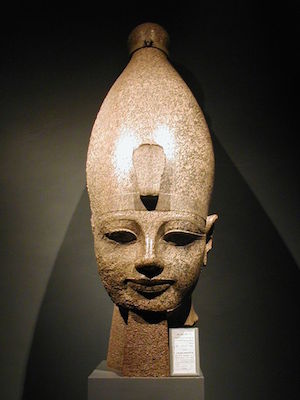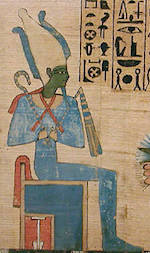The kings and queens of Egypt wore complex and beautiful crowns to signify their power and position. Some kings and queens seem to have been particularly fond of certain crowns, and some were particularly associated with certain gods.
Deshret (Red Crown)

The Deshret (The Red One) confirmed the king as the ruler of Lower Egypt. Although no example of these crowns survive (that we know of), scholars have proposed that they were made of fabric or leather with a wire, possibly of copper, ending in a spiral.
The red crown, or deshret, may very well have originated in Upper Egypt, although it eventually became associated as the symbol of Lower Egypt. A sherd from a large vessel dated to late Naqada I, near the town of Nubt, the city of Set, has a representation in relief of the red crown, and on both the Narmer palette (one side) and macehead the king’s figure is shown wearing the red crown.
According to Egyptian mythology, the Deshret was first given to the god Horus by Geb to symbolize his rule over Lower Egypt. It was worn by the goddess Wadjet and was also referred to as “nt” from the Middle Kingdom because of its association with the goddess Neith.
Hedjet (White Crown)
The Hedjet (The White, or Bright One) was always associated with Upper Egypt and confirmed the rule of the king over southern Egypt. Evidence from Cemetery U and the tomb U-j (dating to Naqada IIIA period of Predynastic Egypt) confirms that this symbol is very old indeed, but like the red crown, no example has been recovered leaving us to guess at its composition.


The White Crown is depicted on one side of the Narmer Palette. It remained popular throughout Egyptian history and was also worn by gods with a particular connection to upper Egypt, notably Nekhbet, the vulture goddess of Nekhebet, and Horus of Nekhen (Hierakonpolis).
Pschent (Double Crown)
At the dawn of the Pharonic Period, king Narmer was depicted on one face of the Narmer Palette wearing the White Crown smiting a northern enemy, and on the other face wearing the Red Crown. Before long this idea was taken to its conclusion and the two crowns merged to become Pschent, the Double Crown. The double crown (also known as “Sekhemti” – “the Two Powerful Ones”) symbolized the king’s rule of both Upper and Lower Egypt.

The Red Crown and the White Crown were sometimes seen as the manifestations of Wadjet and Nekhbet, and so the front of the Double Crown is often embellished with the cobra (representing the goddess Wadjet of Lower Egypt) and vulture (representing the goddess Nekhbet of Upper Egypt).
Although the crowns were regularly worn separately in earlier periods, from the Nineteenth Dynasty onward they are rarely depicted alone. From the time of Tuthmosis IV, they were sometimes combined with another crown – the Nemes.
Nemes
The Nemes is not strictly a crown, but rather a striped head cloth. It covered the whole head, sometimes extending a little way down the back, and had two long flaps which hung down behind the ears and in front of both shoulders. The earliest depiction of the nemes (along with a uraeus) is the ivory label of Den from the First Dynasty. In addition to the ureas, it was sometimes combined with the double crown (for example on the large statues of Ramesses II outside Abu Simbel).


Khepresh (Blue Crown)

The Khepresh (also known as the blue crown) was made from cloth or leather stained blue and was covered with small yellow sun discs. It is known as a war crown by some largely because Ramesses II (the Great) was depicted wearing it in the reliefs of the Battle of Kadesh, However, its use does not seem to have been limited to warfare. The earliest reference to this crown is from the reign of Neferhotep III (Second Intermediate Period. It may have evolved from the more simple cap crown worn in earlier periods, but became more and more elaborate. By the Eighteenth Dynasty it had become so popular that some pharaohs adopted it as their primary crown. It seems to have fallen out of favour during the Twenty-Fifth Dynasty
The Atef

The Atef Crown was the crown of Osiris, although it was also worn by Sobek, Heryshef, Satet and other deities when combined with Osiris (such as Sokar). It is composed of a central element much like the Hedjet (the White Crown of Upper Egypt), woven from plant stems and flanked by two red ostrich feathers. It was worn on top of a wig adorned with the simple circlet and horns. From the New Kingdom onward it was sometimes topped with a sun disk and uraei.
The earliest depiction of the Atef Crown dates to the reign of Sahure in the Fifth Dynasty of the Old Kingdom. It is speculated that the word atef may mean “his might” or “his terror”, but this has not been confirmed.
HemHem
During the reign of Akhenaten a new variant of the Atef known as the Hemhem (or Triple Atef) seems to have replaced the traditional Atef. It was popular during the Ptolemaic Period and was also adopted by non Egyptian rulers such as Natakamani, Arnekhamani, and Cyrus the Great.

The Hemhem was formed from reeds and ostrich feathers topped by sun disks set on top of a pair of long spiral ram’s horns with a cobra on either side of the crown. A variant in which the sun disks were replaced by falcons is thought to reinforce dominion over Lower Egypt. It is sometimes referred to as “The Roaring One” as the word “hemhem” means “to shout” or “cry out”, and it is thought by some that it may have represented a battle horn.
Heka, the god of magic, wore the Triple Atef. It also appears in depictions of the solar child emerging from the lotus flower in the morning, and may also identify the king with the sun god at sunrise.
Bibliography
- Allen, James P. (2010) Middle Egyptian
- Bard, Kathryn (2008) An introduction to the Archaeology of Ancient Egypt
- Kemp, Barry J (1991) Ancient Egypt: Anatomy of a Civilisation
- Wilkinson, Toby A H (1999) Early Dynastic Egypt
- Wilkinson, Richard H. (2003) The Complete Gods and Goddesses of Ancient Egypt
Copyright J Hill 2016